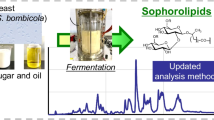Summary
The rapid, quantitative release of astaxanthin and other carotenoids from the yeast Phaffia rhodozyma is described. Hashed cells are ruptured with dimethylsulfoxide (DMSO) and carotenoids extracted into an organic solvent. Extraction and spectrophotometric quantitation of total carotenoids is rapid, reproducible and only small volumes (0.1–2 ml) of culture are required. HPLC analysis in normal phase silica gel column indicates that astaxanthin comprises 65–95% of the total pigmented carotenoids of P. rhodozyma.
Similar content being viewed by others
References
An, G.-H., Schuman, D.B., and Johnson, E.A. (1989) Applied Environ. Microbiol. 55, 116–124.
Haard, N.F. (1988) Biotech. Letters 10, 609–614.
Ruddat, M., and Will O.H. III (1985) Meth. Enzymol. 111, 189–200.
Torrissen, O.J. (1986) Aquaculture 53, 271–278.
Author information
Authors and Affiliations
Rights and permissions
About this article
Cite this article
Sedmak, J.J., Weerasinghe, D.K. & Jolly, S.O. Extraction and quantitation of astaxanthin from Phaffia rhodozyma. Biotechnol Tech 4, 107–112 (1990). https://doi.org/10.1007/BF00163282
Revised:
Issue Date:
DOI: https://doi.org/10.1007/BF00163282




